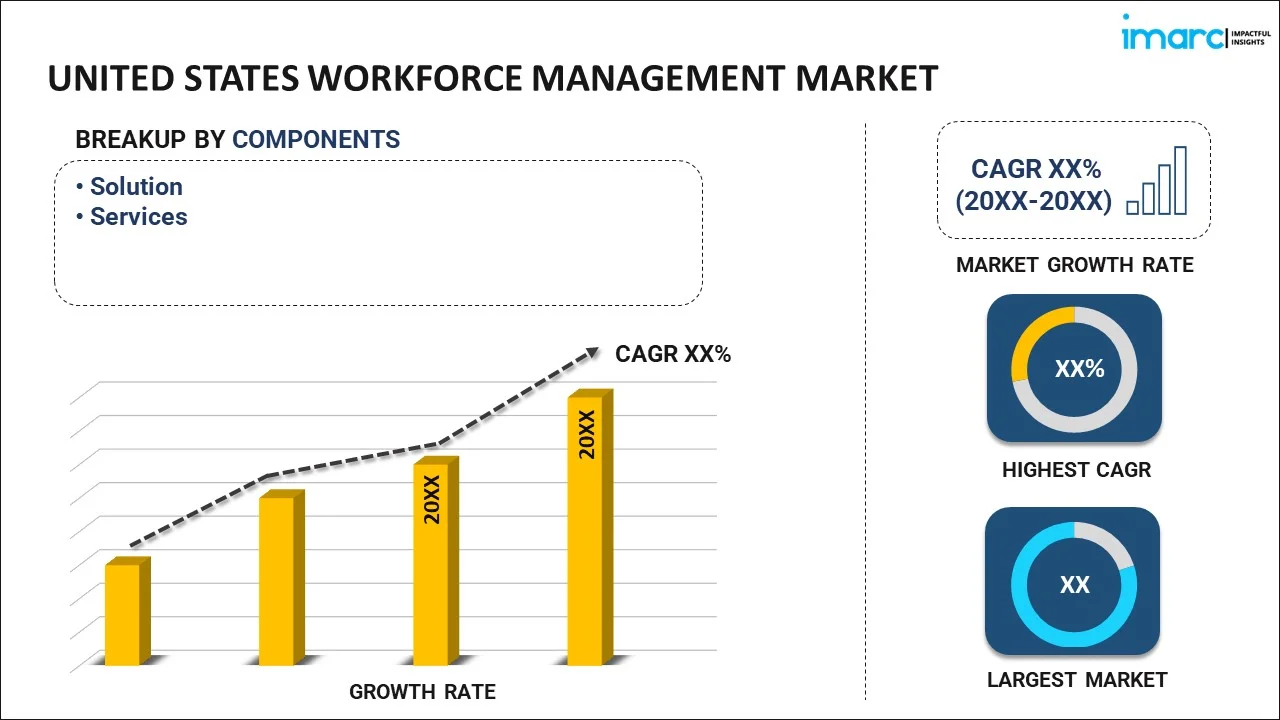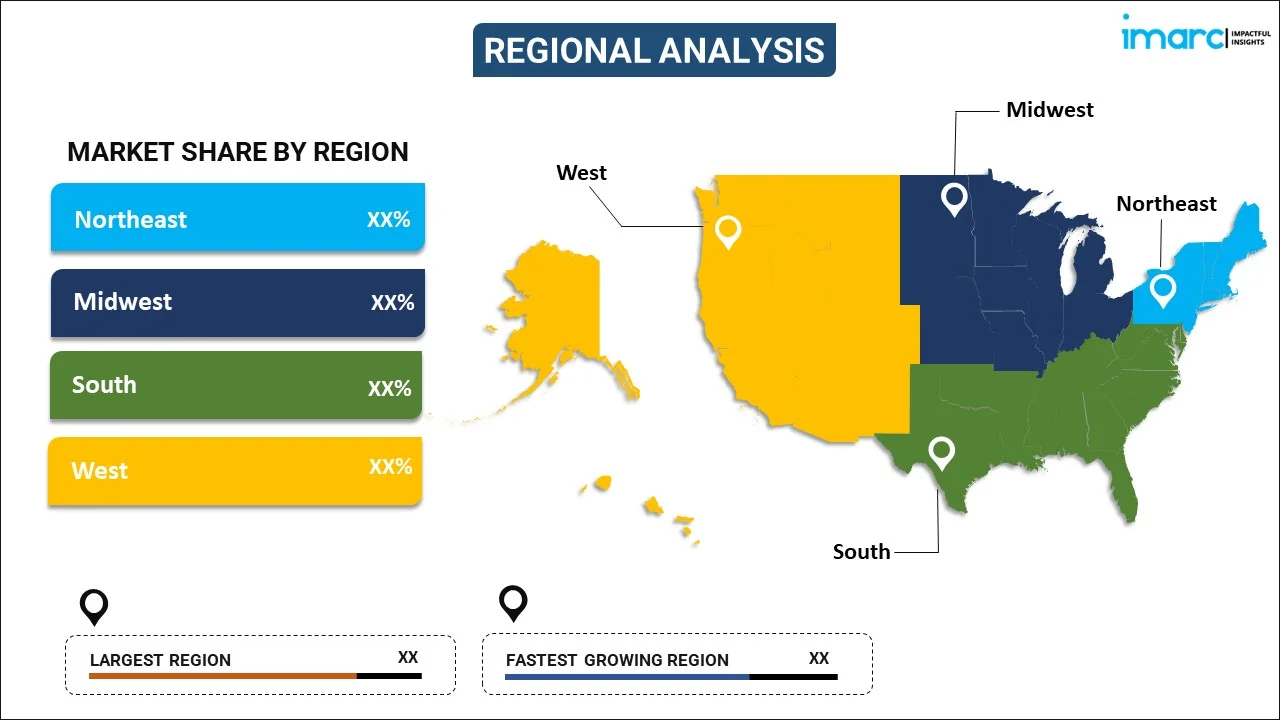
United States Workforce Management Market Report by Component (Solution, Services), Deployment Type (Cloud-based, On-premises), Organization Size (Small and Medium-sized Enterprises (SMEs), Large Enterprises), Vertical (Government and Defense, Banking, Financial Services, and Insurance (BFSI), Healthcare, Transportation and Logistics, Telecom and IT, Consumer Goods and Retail, Manufacturing, Energy and Utilities, and Others), and Region 2025-2033
Market Overview:
United States workforce management market size is projected to exhibit a growth rate (CAGR) of 9.03% during 2025-2033. The integration of advanced technologies, growing trend of remote and hybrid work models, the implementation of strict labor laws and regulations, rapid expansion of the gig economy, and the escalating need for data-driven decision-making represent some of the key factors driving the market.
|
Report Attribute
|
Key Statistics
|
|---|---|
|
Base Year
|
2024 |
|
Forecast Years
|
2025-2033 |
|
Historical Years
|
2019-2024
|
| Market Growth Rate (2025-2033) | 9.03% |
Workforce management (WFM) refers to a set of processes used by organizations to optimize the productivity of their employees. It encompasses a wide range of activities, including employee scheduling, time and attendance tracking, demand prediction, performance management, and compliance with labor laws and regulations. WFM integrates various components, such as software systems, methodologies, and practices to manage staff effectively. It offers several key features, including real-time data analysis, automated scheduling, employee self-service portals, absence and leave management, and advanced reporting capabilities. Workforce management finds applications across multiple sectors, such as healthcare, retail, manufacturing, information technology (IT), and financial services for staff scheduling, payroll management, talent management, time tracking, performance analysis, compliance monitoring, budgeting, forecasting, employee engagement, and strategic decision-making. It aids in increasing operational efficiency, improving employee satisfaction, optimizing resource allocation, enhancing compliance with labor laws, reducing administrative costs, improving workforce analytics, supporting decision-making, promoting transparency in operations, and boosting overall productivity. In addition, WFM is known for its ability to predict workforce needs, manage workforce diversity, and adapt to changing market demands.
United States Workforce Management Market Trends:
The integration of advanced technologies, such as artificial intelligence (AI), machine learning (ML), and the Internet of Things (IoT) in WFM systems to enable predictive analytics for better staff allocation and enhanced decision-making is propelling the market growth. Additionally, the growing trend of remote and hybrid work models, which has increased the need for sophisticated WFM solutions that can manage dispersed workforces effectively, is boosting the market growth. Besides this, the implementation of strict labor laws and regulations in the United States, which necessitates robust WFM systems to ensure compliance and avoid legal complications, is catalyzing the market growth. Furthermore, the rapid expansion of the gig economy, which demands flexible WFM solutions to manage contract-based, part-time, and freelance workers, is contributing to the market growth. In addition, the heightened recognition of the importance of employee engagement for productivity is facilitating the demand for WFM tools that aid in monitoring and enhancing employee satisfaction. Apart from this, the escalating need for data-driven decision-making, prompting the adoption of WFM systems capable of providing insightful analytics on workforce performance and trends, is strengthening the market growth. Moreover, the widespread adoption of WFM solutions by organizations to optimize labor costs and improve operational efficiency is acting as another growth-inducing factor. Along with this, the ongoing shift towards cloud-based solutions that offer scalability, flexibility, and cost-effectiveness is driving the market growth. Additionally, the increasing use of mobile devices for workforce management, which allows real-time updates and communication, thus enhancing operational efficiency, is positively impacting the market growth.
United States Workforce Management Market Segmentation:
IMARC Group provides an analysis of the key trends in each segment of the market, along with forecasts at the country level for 2025-2033. Our report has categorized the market based on component, deployment type, organization size, and vertical.
Component Insights:

- Solution
- Absence Management
- Performance Management
- Workforce Scheduling
- Time and Attendance Management
- Workforce Analytics
- Others
- Services
- Implementation Services
- Support and Maintenance Services
- Training and Education Services
The report has provided a detailed breakup and analysis of the market based on the component. This includes solution (absence management, performance management, workforce scheduling, time and attendance management, workforce analytics, and others) and services (implementation services, support and maintenance services, and training and education services).
Deployment Type Insights:
- Cloud-based
- On-premises
A detailed breakup and analysis of the market based on deployment type have also been provided in the report. This includes cloud-based and on-premises.
Organization Size Insights:
- Small and Medium-sized Enterprises (SMEs)
- Large Enterprises
The report has provided a detailed breakup and analysis of the market based on the organization size. This includes small and medium-sized enterprises (SMEs) and large enterprises.
Vertical Insights:
- Government and Defense
- Banking, Financial Services, and Insurance (BFSI)
- Healthcare
- Transportation and Logistics
- Telecom and IT
- Consumer Goods and Retail
- Manufacturing
- Energy and Utilities
- Others
A detailed breakup and analysis of the market based on vertical have also been provided in the report. This includes government and defense, banking, financial services, and insurance (BFSI), healthcare, transportation and logistics, telecom and IT, consumer goods and retail, manufacturing, energy and utilities, and others.
Regional Insights:

- Northeast
- Midwest
- South
- West
The report has also provided a comprehensive analysis of all the major regional markets, which include the Northeast, Midwest, South, and West.
Competitive Landscape:
The market research report has also provided a comprehensive analysis of the competitive landscape in the market. Competitive analysis such as market structure, key player positioning, top winning strategies, competitive dashboard, and company evaluation quadrant has been covered in the report. Also, detailed profiles of all major companies have been provided.
United States Workforce Management Market Report Coverage:
| Report Features | Details |
|---|---|
| Base Year of the Analysis | 2024 |
| Historical Period | 2019-2024 |
| Forecast Period | 2025-2033 |
| Units | Million USD |
| Scope of the Report | Exploration of Historical Trends and Market Outlook, Industry Catalysts and Challenges, Segment-Wise Historical and Future Market Assessment:
|
| Components Covered |
|
| Deployment Types Covered | Cloud-based, On-premises |
| Organization Sizes Covered | Small and Medium-sized Enterprises (SMEs), Large Enterprises |
| Verticals Covered | Government and Defense, Banking, Financial Services, and Insurance (BFSI), Healthcare, Transportation and Logistics, Telecom and IT, Consumer Goods and Retail, Manufacturing, Energy and Utilities, Others |
| Regions Covered | Northeast, Midwest, South, West |
| Customization Scope | 10% Free Customization |
| Post-Sale Analyst Support | 10-12 Weeks |
| Delivery Format | PDF and Excel through Email (We can also provide the editable version of the report in PPT/Word format on special request) |
Key Questions Answered in This Report:
- How has the United States workforce management market performed so far and how will it perform in the coming years?
- What has been the impact of COVID-19 on the United States workforce management market?
- What is the breakup of the United States workforce management market on the basis of component?
- What is the breakup of the United States workforce management market on the basis of deployment type?
- What is the breakup of the United States workforce management market on the basis of organization size?
- What is the breakup of the United States workforce management market on the basis of vertical?
- What are the various stages in the value chain of the United States workforce management market?
- What are the key driving factors and challenges in the United States workforce management?
- What is the structure of the United States workforce management market and who are the key players?
- What is the degree of competition in the United States workforce management market?
Key Benefits for Stakeholders:
- IMARC’s industry report offers a comprehensive quantitative analysis of various market segments, historical and current market trends, market forecasts, and dynamics of the United States Workforce Management market from 2019-2033.
- The research report provides the latest information on the market drivers, challenges, and opportunities in the United States Workforce Management market.
- Porter's five forces analysis assist stakeholders in assessing the impact of new entrants, competitive rivalry, supplier power, buyer power, and the threat of substitution. It helps stakeholders to analyze the level of competition within the United States Workforce Management industry and its attractiveness.
- A competitive landscape allows stakeholders to understand their competitive environment and provides an insight into the current positions of key players in the market.
Need more help?
- Speak to our experienced analysts for insights on the current market scenarios.
- Include additional segments and countries to customize the report as per your requirement.
- Gain an unparalleled competitive advantage in your domain by understanding how to utilize the report and positively impacting your operations and revenue.
- For further assistance, please connect with our analysts.
 Inquire Before Buying
Inquire Before Buying
 Speak to an Analyst
Speak to an Analyst
 Request Brochure
Request Brochure
 Request Customization
Request Customization




.webp)




.webp)












